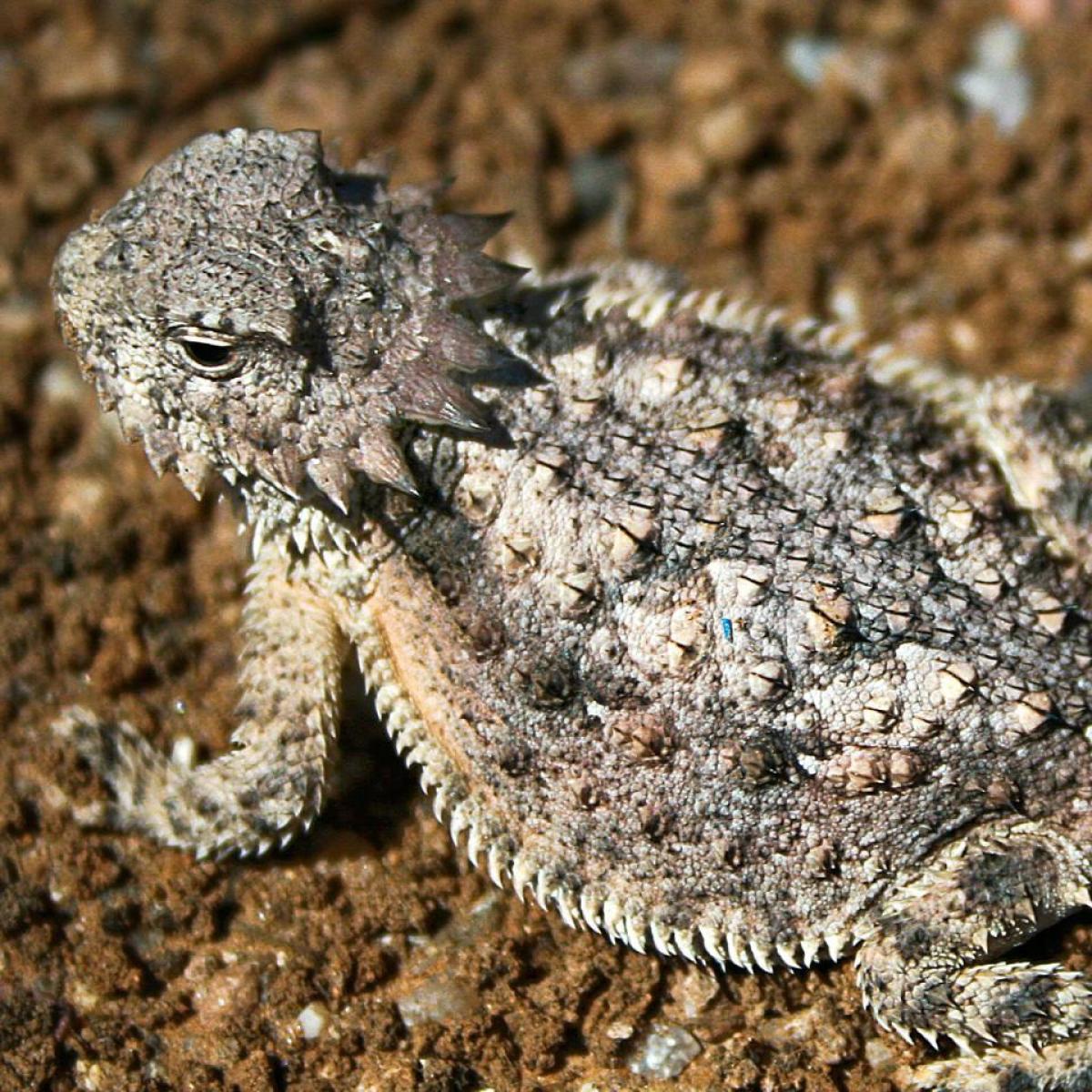T-Cells

T-cells are a type of white blood cell that work with macrophages. Unlike macrophages that can attack any invading cell or virus, each T-cell can fight only one type of virus. You might think this means macrophages are stronger than T-cells, but they aren’t. Instead, T-cells are like a special forces unit that fights only one kind of virus that might be attacking your body.
More than one kind of T-cell
There are two types of T-cells in your body: Helper T-cells and Killer T-cells. Killer T-cells do the work of destroying the infected cells. The Helper T-cells coordinate the attack.
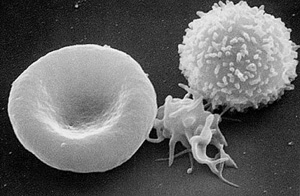
Killer T-Cells and Antigens
Killer T-cells find and destroy infected cells that have been turned into virus-making factories. To do this they need to tell the difference between the infected cells and healthy cells with the help of special molecules called antigens. Killer T-cells are able to find the cells with viruses and destroy them.
Antigens work like identification tags that give your immune system information about your cells and any intruders. Healthy cells have 'self-antigens' on the surface of their membranes. They let T-cells know that they are not intruders. If a cell is infected with a virus, it has pieces of virus antigens on its surface. This is a signal for the Killer T-cell that lets it know this is a cell that must be destroyed.

Anatomy of a T-cell
T-cells have many identical T-cell receptors that cover their surfaces and can only bind to one shape of antigen. When a T-cell receptor fits with its viral antigen on an infected cell, the Killer T-cell releases cytotoxins to kill that cell.
The key to finding infected cells
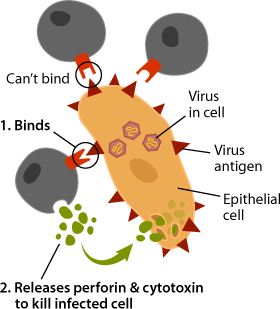
There are 25 million to a billion different T-cells in your body. Each cell has a unique T-cell receptor that can fit with only one kind of antigen, like a lock that can fit with only one shape of key. Antigens and receptors work a lot like a lock and key. Most of these antigens will never get in your body, but the T-cells that patrol your body will recognize them if they do.
The T-cell receptor fits with its antigen like a complex key. When the perfectly shaped virus antigen on an infected cell fits into the Killer T-cell receptor, the T-cell releases perforin and cytotoxins. Perforin first makes a pore, or hole, in the membrane of the infected cell. Cytotoxins go directly inside the cell through this pore, destroying it and any viruses inside. This is why Killer T-cells are also called Cytotoxic T-cells. The pieces of destroyed cells and viruses are then cleaned up by macrophages.
Helper T-cells
The other type of T-cell is the Helper T-cell. These cells don’t make toxins or fight invaders themselves. Instead, they are like team coordinators. They use chemical messages to give instructions to the other immune system cells. These instructions help Killer T-cells and B-cells make a lot more of themselves so they can fight the infection and make sure the fight stays under control.
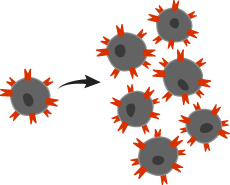
Building a bigger army for a particular invader
When a Helper T-cell sends out a chemical message, its matched Killer T-cell is alerted that there is a virus present. After a Killer T-cell finds and destroys an infected cell, this Helper T-cell message tells it to copy itself, making an army of Killer T-cells. Because only T-cells that can fight the invading virus are copied, your body saves energy and is still very good at killing the virus.
T-cell screening
T-cells are made in the bone marrow, like all red and white blood cells. The name T-cell comes from the organ where they mature, the thymus. The thymus is just above your heart, and is about the size of a deck of playing cards. Most T-cells are made when you’re young, so kids have a bigger thymus than adults. It is also where T-cells are screened to get rid of any that would attack the healthy cells in your body.
Getting around the body
All white blood cells have two ways to get around the body. One way is through your blood vessels. The other way is through the lymph system.
The lymph system has vessels that move milky fluid and white blood cells around the body. Unlike your heart, which pumps your blood, the lymph system uses the movements of your body to push the lymph fluid around. This is one reason why it is good to be active and exercise.
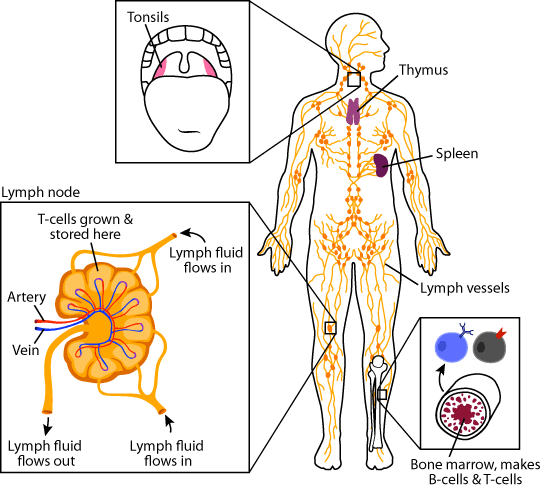
Switching transportation systems
Most white blood cells are stored in the lymph system until they are needed to fight an infection. When a virus attacks, they can transfer into the blood vessels so they can quickly attack the viruses. This transfer happens in the lymph nodes, which are located throughout your body.
Lots of lymph nodes are in your legs, armpits, and neck. The last time you had a sore throat you probably felt enlarged places on one or both sides of your neck. This is where the T-cells and B-cells multiply and get ready to attack the virus.
Other important parts of the lymph system where immune cells grow, multiply, and trap invaders are your bone marrow, thymus, spleen, and tonsils.
Bibliographic details:
- Article: T-cells
- Author(s): Dr. Biology
- Publisher: Arizona State University School of Life Sciences Ask A Biologist
- Site name: ASU - Ask A Biologist
- Date published: 16 Feb, 2011
- Date accessed:
- Link: https://askabiologist.asu.edu/t-cell
APA Style
Dr. Biology. (Wed, 02/16/2011 - 11:21). T-cells. ASU - Ask A Biologist. Retrieved from https://askabiologist.asu.edu/t-cell
Chicago Manual of Style
Dr. Biology. "T-cells". ASU - Ask A Biologist. 16 Feb 2011. https://askabiologist.asu.edu/t-cell
Dr. Biology. "T-cells". ASU - Ask A Biologist. 16 Feb 2011. ASU - Ask A Biologist, Web. https://askabiologist.asu.edu/t-cell
MLA 2017 Style
Be Part of
Ask A Biologist
By volunteering, or simply sending us feedback on the site. Scientists, teachers, writers, illustrators, and translators are all important to the program. If you are interested in helping with the website we have a Volunteers page to get the process started.


